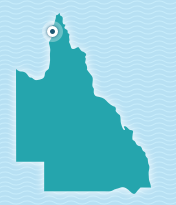Weipa
The map below shows the historical extent of seagrass presence within our monitoring areas over the past ten years. We aim to monitor in three-year cycles, completing a larger survey of the broadscale area every three years and smaller surveys in the intervening years.
Like most plants, seagrass responds to changes in its natural environment. So we also keep track of environmental influencers, such as light and temperature that may impact the distribution and condition of seagrass growing within our monitoring areas.
Many environmental influencers and events can impact the marine ecosystem. Major weather events that are particularly relevant in North Queensland are cyclones. Cyclones typically generate extreme energy environments, with large waves and intense winds, both of which can have a strong physical impact on seagrass and their seed banks within the sediments such as burial, scouring, or direct removal of plants or seeds. Secondary impacts caused by associated high rainfall—such as changes in salinity, turbidity and nutrient levels during or leading up to the growing season—may also affect the seagrass.
These charts are developed based on the data for the Mission River seagrasses which are surveyed on an annual basis. While the broadscale extent of seagrass is shown in the above interactive map, these are also coastal seagrasses and therefore have similar growth patterns and responses to stressors. For this reason, the below charts are focused only on the more comprehensive annual data set. Further detail on the methods for monitoring can be found in these reports.
-
Higher water temperatures can make it difficult for seagrass to grow. A prolonged period of time of high water temperatures during the growing season, as well as an above-average water temperature for the year, can indicate pressure on coastal seagrass condition.
Water temperature over 10 years -
Solar radiation is a way of measuring the intensity of the sun as it falls on the water surface. High solar radiation may offer benefit to seagrasses by providing more energy for photosynthesis. However, when this is coupled with extended periods of high water temperature or extended periods of daytime exposure to air at low tide, we are, likely to see seagrass come under increased pressure (see below for density charts).
Solar radiation over 10 years -
As seagrasses need light to survive, they are sensitive to any pressures that may reduce the light available to them. High rainfall can lead to increased runoff from the land, turbid water flows into coastal environments and local coastal re-suspension that result in reduced levels of light reaching the ocean floor making it difficult for seagrasses to survive. In extreme cases high rainfall and flooding can also reduce the salinity of the water which may also cause stress to seagrasses.
Rainfall over 10 years

The chart to the right shows annual seagrass extent as a percentage of our total annual monitoring survey area.
The seagrasses around Weipa are dominated by the large species Enhalus acoroides and the smaller H. uninervis. E. acoroides forms stable, persistent communities that generally don’t change in area much from year to year. E. acoroides found in intertidal and shallow areas is well adapted to cope with typical wet-season reductions in light, as is a frequent occurrence in this tropical North Queensland location. H. uninervis forms meadows that are relatively persistent but area coverage of the meadows varies more from year to year for this faster growing species.
Seagrasses in this region have maintained a coverage of between 60 percent and 80 percent over the past 10 years.
Seagrass density can be an important indicator of the health of a seagrass community. Denser seagrass communities can provide more complex habitat structure and protection for animals that use them as nursery grounds, and may also provide more food for turtles, dugongs and other marine animals.
In our monitoring areas, density is a representation of above ground biomass of seagrass within each monitoring area.
Despite the relatively stable seagrass area coverage (percentage) noted above, the chart on the right shows that the density of Weipa seagrass is more variable, albeit predominantly in the moderate or high density category. High levels of temperature, solar radiation and tidal exposure have been shown to impact seagrass within these communities with likely impacts on the overall density of the meadow.
You can see more analysis on the data in these reports. You can also download the data used to create this chart.
All data presented on this page has been compiled using data collected by James Cook University on behalf of North Queensland Bulk Ports. Every effort has been made to ensure its accuracy; however, errors can occur. If you notice anything that looks incorrect, please feel free to contact us to let us know. We will always do our best to rectify any errors as soon as we are aware of them.
Seagrass surveys are conducted during every growing season and we aim to upload new seagrass data for the prior year by the second quarter of each subsequent calendar year.